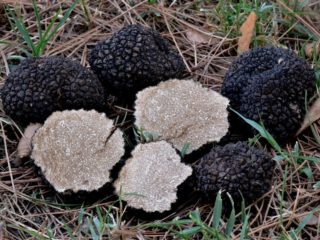Content
Burgundy truffle is a rare, tasty and healthy mushroom from the Truffle family. Grows on the roots of deciduous and, less commonly, coniferous trees. Since the price for this species is very high, many mushroom pickers study the rules of collection, look at photos and videos. And having learned the secrets of mushroom picking, they receive good income from sales and gastronomic pleasure.
What does a Burgundy truffle look like?
The tuberous fruiting body of the Burgundy truffle is spherical in shape, weighing up to 500 g. The surface is covered with multifaceted dark brown growths. In young specimens, the flesh is whitish when cut; with age, it becomes light brown and acquires a characteristic marble pattern.The mushroom has a chocolate taste and a pronounced nutty aroma. Reproduction occurs by oblong spores, which are located in brown powder.

You can recognize a truffle by its marble pattern.
Where does the French truffle grow?
The Burgundy truffle grows underground, in deciduous and, less commonly, coniferous forests. Fruiting begins in September and lasts until mid-February. Since there are inedible species in nature, you need to carefully familiarize yourself with the external data, view photos and videos.
Can you eat Burgundy truffle?
The Burgundy truffle is a delicious mushroom, but in some sources it is classified as conditionally edible. Due to its good taste and aroma, the mushroom is used fresh as an addition to fish and meat dishes; sauces, oils, soups and strong alcoholic drinks are also often flavored with mushroom shavings.
False doubles
This representative of the mushroom kingdom, like any inhabitant of the forest, has similar brothers. These include:
- Perigordsky – a delicious, valuable mushroom that grows in regions with warm climates. It is located underground, so collection is difficult and does not always bring positive results. The species can be recognized by its deep black color and dark purple flesh with whitish veins. The firm pulp has a strong nutty aroma and bitter taste. Fruiting lasts from December to March.
Périgord truffle is the most valuable and expensive type
- Summer – edible species with light gray flesh, delicate taste and pleasant aroma. Grows on the roots of deciduous trees. The mushroom can be recognized by its dark blue surface, which is covered with numerous pyramidal growths.Ripening depends on climatic conditions and occurs from July to November. In cooking it is used fresh to add flavor to fish and meat dishes.
Rules for collection and use
Collecting truffles is a difficult, time-consuming job, since the mushroom lies underground and is difficult to detect without certain skills. Experienced mushroom pickers find mycelium by raised soil, dried grass and clusters of yellow-winged insects. They circle above the mycelium and lay their larvae on the fruiting bodies.

Truffle is a favorite delicacy of pigs; they can smell it at a distance of 25 m
In cooking, Burgundy truffles are used fresh. It perfectly complements fish and meat dishes, salads and sauces. It is also often served with fruits, nuts, honey and spirits.
If the mushroom hunt was positive, the mushroom can be stored in a cool place for 7 days. Also, to extend the shelf life, the found truffles are poured with cognac or olive oil.
The Burgundy truffle has found wide application not only in cooking, but also in folk medicine and cosmetology. The mushroom contains vitamins, proteins, carbohydrates and dietary fiber. Thanks to its beneficial composition, mushroom powder is used to treat joints, truffle-based drops help with eye diseases; when consumed fresh, the mushroom removes toxins and waste, reduces bad cholesterol and blood sugar, improves the functioning of the endocrine system, increases immunity and relieves depressive syndrome .
Burgundy truffle is often used to make face masks.But only wealthy people can afford these products, since 3-4 fruiting bodies are used to prepare one product. The cosmetic procedure eliminates wrinkles, smoothes the skin, gives it freshness and youth.
Conclusion
The Burgundy truffle is a delicious, valuable species that grows in regions with warm climates. Due to its beneficial properties and good taste, it is used in cooking, medicine and cosmetology. But in order not to overpay for the product, you can learn the rules of collection, find out the time and place of fruiting. Having mastered all the skills, you can not only satisfy your culinary needs, but also rise in material terms.










